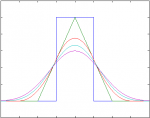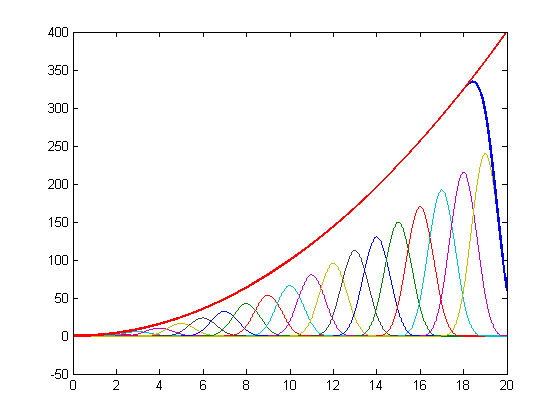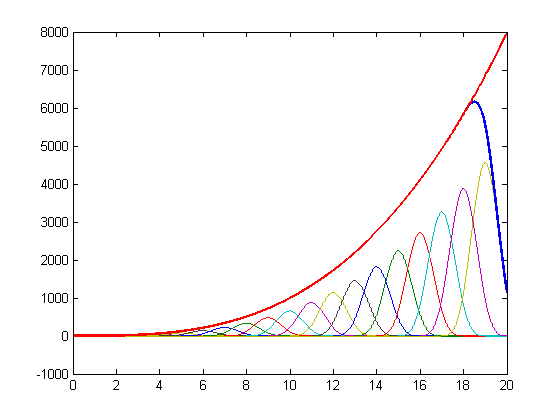Reproducing Polynomials with B-Splines: Unterschied zwischen den Versionen
Niki (Diskussion | Beiträge) |
Niki (Diskussion | Beiträge) |
||
| (9 dazwischenliegende Versionen desselben Benutzers werden nicht angezeigt) | |||
| Zeile 1: | Zeile 1: | ||
<section begin="head"/> | <section begin="head"/> | ||
| − | [[Datei: | + | [[Datei:bspline_family.png|right|150px|Family of B-splines up to N=4]] |
| − | A B-Spline of order <math>N</math> is known to be able to reproduce any polynomial up to order <math>N</math | + | A B-Spline of order <math>N</math> is known to be able to reproduce any polynomial up to order <math>N</math>: |
<math> | <math> | ||
| Zeile 7: | Zeile 7: | ||
</math> | </math> | ||
| − | In words, a proper linear combination of shifted versions of a B-Spline can reproduce any polynomial up to order <math>N</math>. This is needed for different applications, for example, for the Sampling at Finite Rate of Innovation (FRI) framework | + | In words, a proper linear combination of shifted versions of a B-Spline can reproduce any polynomial up to order <math>N</math>. This is needed for different applications, for example, for the Sampling at Finite Rate of Innovation (FRI) framework. In this case any kernel <math>\varphi</math> reproducing polynomials (that is, satisfying the Strang-Fix conditions) can be used. However, among all possible kernels, the B-Splines have the smallest possible support. |
An important question is how to obtain the coefficients <math>c_{m,n}</math> for the reproduction-formula. In this small article, I describe one way. | An important question is how to obtain the coefficients <math>c_{m,n}</math> for the reproduction-formula. In this small article, I describe one way. | ||
| Zeile 18: | Zeile 18: | ||
</math> | </math> | ||
| − | the coefficients can be obtained using the dual of <math>\varphi</math>, <math>\tilde{\varphi}</math> (I set <math>\beta_N = \varphi</math> for consistency with my notes): | + | the coefficients can be obtained using the dual of <math>\varphi</math>, <math>\tilde{\varphi}</math><ref>P.L. Dragotti, M. Vetterli, T.Blu: "Sampling Moments and Reconstructing Signals of Finite Rate of Innovation: Shannon Meets Strang-Fix", ''IEEE Transactions on Signal Processing'', vol. 55, No. 5, May 2007</ref> (I set <math>\beta_N = \varphi</math> for consistency with my notes): |
<math> | <math> | ||
| Zeile 56: | Zeile 56: | ||
</math> | </math> | ||
| − | Now the whole procedure has been reduced to | + | Now the whole procedure has been reduced to calculating the derivative of <math>f(\omega)</math> and set the result to zero. |
| − | An open question is how to obtain the dual of <math>\varphi</math>. As the reproduction formula spans a vector space, | + | An open question is how to obtain the dual of <math>\varphi</math>. As the reproduction formula spans a vector space, <math>\varphi</math> must be at least bi-orthogonal to <math>\tilde{\varphi}</math>. This translates in fourier domain to<ref>S. Mallat: "A Wavelet Tour of Signal Processing", ''Academic Press'' 1999</ref>: |
<math> | <math> | ||
| Zeile 71: | Zeile 71: | ||
</math> | </math> | ||
| − | The following derivation of the sum is borrowed from <ref>M.J.C.S. Reis, P.J.S.G. Ferreira, S.F.S.P. Soares: "Linear combinations of B-splines as generating functions for signal approximation", ''Elsevier Digital Signal Processing 15'', 2005</ref>. For this derivation to work, I set <math>L=N+1</math> | + | The following derivation of the sum is borrowed from <ref>M.J.C.S. Reis, P.J.S.G. Ferreira, S.F.S.P. Soares: "Linear combinations of B-splines as generating functions for signal approximation", ''Elsevier Digital Signal Processing 15'', 2005</ref>. For this derivation to work, I set <math>L=N+1</math> temporarily: |
<math> | <math> | ||
| Zeile 95: | Zeile 95: | ||
<math> | <math> | ||
| − | = \sin^{2L}(\frac{\omega}{2}) \sum_{k \in \mathbb{Z}}\frac{1}{(\frac{\omega}{2} + \pi k)^{2L}} | + | = \sin^{2L}\left(\frac{\omega}{2}\right) \sum_{k \in \mathbb{Z}}\frac{1}{(\frac{\omega}{2} + \pi k)^{2L}} |
</math> | </math> | ||
| − | And finally the following relation is used: | + | And finally the following relation is used<ref>L.V. Ahlfors: "Complex Analysis", ''McGraw-Hill'', 1979</ref>: |
<math> | <math> | ||
| Zeile 136: | Zeile 136: | ||
</math> | </math> | ||
| − | + | = Examples for a cubic spline = | |
For a cubic spline (N=3) the coefficients are: | For a cubic spline (N=3) the coefficients are: | ||
| − | \begin{array}{ | + | <math> |
| + | \begin{array}{lcl} | ||
c_{0,n} & = & 1 \\ | c_{0,n} & = & 1 \\ | ||
c_{1,n} & = & n \\ | c_{1,n} & = & n \\ | ||
| Zeile 146: | Zeile 147: | ||
c_{3,n} & = & -n + n^3 | c_{3,n} & = & -n + n^3 | ||
\end{array} | \end{array} | ||
| + | </math> | ||
| + | |||
| + | [[Datei:poly_repro_quad.png|center|cubic spline reproducing polynomial of order 2]] | ||
| + | [[Datei:poly_repro_cubic.png|center|cubic spline reproducing polynomial of order 3]] | ||
| + | = References = | ||
| − | = | + | <ref name="schoenberg">I.J. Schoenberg: "Cardinal interpolation and spline functions", ''J. Approx. Theory volume 2'', pp. 167-206, 1969</ref> |
<references/> | <references/> | ||
| + | |||
| + | = Comments = | ||
| + | |||
| + | <comments />{{:{{TALKSPACE}}:{{PAGENAME}}}} | ||
| + | |||
| + | [[Kategorie:Weblog]] | ||
Aktuelle Version vom 19. Juli 2010, 15:45 Uhr
A B-Spline of order is known to be able to reproduce any polynomial up to order :
In words, a proper linear combination of shifted versions of a B-Spline can reproduce any polynomial up to order . This is needed for different applications, for example, for the Sampling at Finite Rate of Innovation (FRI) framework. In this case any kernel reproducing polynomials (that is, satisfying the Strang-Fix conditions) can be used. However, among all possible kernels, the B-Splines have the smallest possible support.
An important question is how to obtain the coefficients for the reproduction-formula. In this small article, I describe one way.
Starting from
the coefficients can be obtained using the dual of , [1] (I set for consistency with my notes):
However, even if the dual would be known, solving the infinite integral is only feasible when the dual has finite support. This is the case with the B-Spline itself but not with its dual!
A closer look at the formula tells that this is nothing more than a convolution (under the assumption that is symmetric which is the case):
Now, this can be transformed to fourier domain:
Writing the inverse of this expression yields:
It is known that[2]:
so that
Now the whole procedure has been reduced to calculating the derivative of and set the result to zero.
An open question is how to obtain the dual of . As the reproduction formula spans a vector space, must be at least bi-orthogonal to . This translates in fourier domain to[3]:
The fourier transform of a B-Spline of order is (e.g. [4]):
The following derivation of the sum is borrowed from [5]. For this derivation to work, I set temporarily:
and because is always even:
Because of the periodicity it is known that
such that
And finally the following relation is used[6]:
in order to finally obtain:
and with :
Therefore, together with this yields:
and finally substituting for :
As this function is not well defined it is better to use the limit:
Examples for a cubic spline
For a cubic spline (N=3) the coefficients are:
References
- ↑ P.L. Dragotti, M. Vetterli, T.Blu: "Sampling Moments and Reconstructing Signals of Finite Rate of Innovation: Shannon Meets Strang-Fix", IEEE Transactions on Signal Processing, vol. 55, No. 5, May 2007
- ↑ http://en.wikipedia.org/wiki/Dirac_delta_function
- ↑ S. Mallat: "A Wavelet Tour of Signal Processing", Academic Press 1999
- ↑ M.Unser: "Splines - A Perfect Fit for Signal and Imaging Processing", IEEE Signal Processing Magazine Nov. 1999
- ↑ M.J.C.S. Reis, P.J.S.G. Ferreira, S.F.S.P. Soares: "Linear combinations of B-splines as generating functions for signal approximation", Elsevier Digital Signal Processing 15, 2005
- ↑ L.V. Ahlfors: "Complex Analysis", McGraw-Hill, 1979
- ↑ I.J. Schoenberg: "Cardinal interpolation and spline functions", J. Approx. Theory volume 2, pp. 167-206, 1969
Comments
<comments />


































Bussi
--Manu 19:47, 19. Jul. 2010 (MSD)